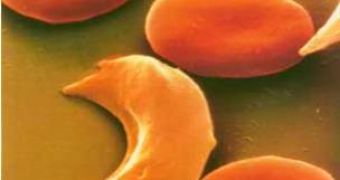The sickle cell anemia is one of the worst hereditary conditions connected to the African race. The mutant gene that causes it is delivered by both parents. In Nigeria, out of a population of 120 million, 1 million people suffer of the sickle cell anemia and 60,000 die annually of it.
Haematids or blood's red cells have the role of transporting oxygen from lungs to tissues and carbon dioxide from tissues to lungs. They do this with the help of the red iron-containing pigment called hemoglobin. Their normal shape is round and this enables them to enter easily into the smallest blood's capillary vessels to deliver the oxygen. But in the case of this genetic disease, the cells lose their round shape, turning banana or sickle shaped.
These cells get stuck into the small vessels, and moreover, they block the access of the normally round shaped cells. When the blood flow towards a body part is decreased, the lack of the necessary oxygen induces a painful crisis of bones and articulations. The crises cannot be forecast, and their monthly rate varies a lot from one month to another. A crisis can last from several hours to a week.
A severe crisis can even block the activity of the brain, lung, heart, kidney or spleen, with deadly consequences. Ulcerations in the ankle areas can last for years. Children can also experience convulsions and apoplexy.
Individuals with sickle cell anemia are extremely vulnerable to infectious diseases, as the condition weaken the immune system. Many of these patients die of infection. Not all sickle cell anemics present all the symptoms. And some may not have any symptom till the end of the teenage.
The first symptoms appear after the baby is 6 month old, and one of the first signs is the swelling of the hands or feet, accompanied by pain. The sclerotic (the white membrane of the eye) can turn yellow, and the tongue, lips and palms can be paler than normal. The blood analysis will confirm the disease.
Being hereditary, the disease cannot be treated, but treatments can decrease the frequency of the crises or stop their evolution. During the crisis, a patient must drink a lot of water, which eases the blood circulation, and a light tranquilizer helps. Adult sickle cell anemics should drink about 3-4 liters of water daily. In case of severe crisis, not even powerful tranquilizers can help too much.
Hydroxyurea is a drug that cuts by half the frequency of the painful crises, as it impedes the red cells from changing their shape, tapping the blood vessels. In emergency cases, blood transfusions are required.
The sickle cell anemia patients should avoid hard efforts, and they should have a healthy diet, rich in vitamins, especially folic acid (vitamin B9).
The children with sickle cell anemia are made by parents carrying each one a mutation. In the case of these individuals, theoretically one quarter of the children will have the condition, when the embryo has inherited a set of mutations. Practically, from all to none of the children of such couples could have this anemia.
The question is: why such a harmful mutation is so spread amongst African population? The answer is linked to malaria. It appears that the individuals carrying one mutation are extremely resistant to this deadly parasite. In this case, the natural selection favored the maintenance, and even the spread of a normally harmful mutation. The gene is also existent amongst Afro-American people, but its frequency is much lower than in Africa, as in the lack of malaria, the selection acted towards the elimination of this mutation.

 14 DAY TRIAL //
14 DAY TRIAL //